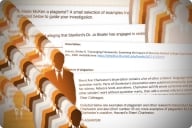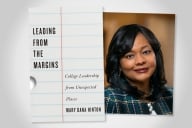You have /5 articles left.
Sign up for a free account or log in.
David F. Labaree's new book makes a somewhat unusual argument to reassure those worried about the future of American higher education. Yes, it has many serious problems, he writes. But it always has and always will. And that is in fact a strength of American higher education, he argues.
Labaree, a professor of education at Stanford University, answered questions via email about his new book, A Perfect Mess: The Unlikely Ascendancy of American Higher Education (University of Chicago Press).
Q: What do you consider the uniquely American qualities in the development of higher education in the U.S.?
A: The American system of higher education emerged in a unique historical setting in the early 19th century, when the state was weak, the market strong and the church divided. Whereas the European university was the creature of the medieval Roman Catholic church and then grew strong under the rising nation-state in the early modern period, the American system lacked the steady support of church or state and had to rely on the market in order to survive. This posed a terrible problem in the 19th century, as colleges had to scrabble around looking for consumers who would pay tuition and for private sponsors who would provide donations. But at the same time, it planted the seeds of institutional autonomy that came to serve the system so well in the next two centuries. Free from the control of church and state, individual colleges learned to survive on their own resources by meeting the needs of their students and their immediate communities.
By the 20th century, this left the system with the proven ability to adapt to circumstances, take advantage of opportunities, build its own sources of political and economic support, and expand to meet demand. Today the highest-rated universities in global rankings of higher education institutions are the ones with the greatest autonomy, in particular as measured by being less dependent on state funds. And American institutions dominate these rankings; according to the Shanghai rankings, they account for 16 of the top 20 universities in the world.
Q: How significant is the decentralization of American higher education, with public and private systems, and publics reflecting very different traditions in different states?
A: Decentralization has been a critically important element in the American system of higher education. The federal government never established a national university, and state governments were slow in setting up their own colleges because of lack of funds. As a result, unlike anywhere else in the world, private colleges in the U.S. emerged before the publics. They were born as not-for-profit corporations with state charters but with little public funding and no public control.
The impulse for founding these colleges had little to do with advancing higher learning. Instead founders established these institutions primarily to pursue two other goals -- to promote the interests of one religious denomination over others and to make land in one town more attractive to buy than land in a neighboring town. Typically, these two aims came together. Developers would donate land and set up a college, seek affiliation with a church, and then use this college as a way to promote their town as a cultural center rather than a dusty agricultural village. Remember that early America had too much land and not enough buyers. The federal government was giving it away. This helps explain why American colleges arose in the largest numbers in the sparsely populated frontier rather than in the established cities in the East -- why Ohio had so many more colleges than Massachusetts or Virginia.
Q: What eras strike you as those in which American higher education was most threatened?
A: American higher education was in the greatest jeopardy in the period after the Civil War. The system was drastically overbuilt. In 1880 the U.S. had more than 800 colleges, five times the number in the entire continent of Europe. Overall, however, they were poor excuses for institutions of higher education. On average they had only 130 students and 10 faculty, which made them barely able to survive from year to year, forced to defer faculty salaries and beg for donations. European visitors loved to write home about how intellectually and socially undistinguished they were.
The system as a whole had only one great asset -- a huge amount of capacity. What it lacked, however, was sufficient students and academic credibility. Fortunately, both of these elements arose in the last quarter of the century to save the day. The rise of white-collar employment in the new corporations and government agencies created demand for people with strong cognitive, verbal and social skills, the kinds of things that students learn in school. And with the public high schools filling up with working-class students, the college became the primary way for middle-class families to provide their children with advantaged access to managerial and professional work. At the same time, the import of the German model of the university, with a faculty of specialized researchers sporting the new badge of merit, the Ph.D., offered American colleges and universities the possibility for academic stature that had so long eluded them. This steady flow of students and newfound academic distinction allowed the system to realize the potential embedded in its expansive capacity and autonomous structure.
Q: You seem to be suggesting not to worry too much about today’s problems, because higher education has always been a “perfect mess.” But are there issues that are notably worse today than in the past?
A: First, let me say a little about the advantages of the system’s messiness. In the next section, I’ll respond about the problem facing the system today. The relative autonomy and decentralization of American higher education allows individual colleges and universities to find their own ways of meeting needs, finding supporters and making themselves useful. They can choose to specialize, focusing on particular parts of the market -- by level of degree, primary consumer base, religious orientation or vocational function. Or, like the big public and private universities, they can choose to provide something for everyone. This makes for individual institutions that don’t have a clean organization chart, looking instead like what some researchers have called “organized anarchies.”
The typical university is in constant tension between autonomous academic departments, which control curriculum and faculty hiring and promotion, and a strong president, who controls funding and is responsible only to the lay board of directors who own the place. Also thrown into the mix are a jumble of independent institutes, research centers and academic programs that have emerged in response to a variety of funding opportunities and faculty initiatives. The resulting institution is a hustler’s paradise, driven by a wide array of entrepreneurial actors: faculty trying to pursue intellectual interests and forge a career; administrators trying to protect and enrich the larger enterprise; and donors and students who want to draw on the university’s rich resources and capitalize on association with its stellar brand. These actors are feverishly pursuing their own interests within the framework of the university, which lures them with incentives, draws strength from their complex interactions and then passes these benefits on to society.
Q: What do you see as the major challenges facing academic leaders today?
A: The biggest problem facing the American system of higher education today is how to deal with its own success. In the 19th century, very few people attended college, so the system was not much in the public spotlight. Burgeoning enrollments in the 20th century put the system center stage, especially when it became the expectation that most people should graduate from some sort of college. As higher education moved from being an option to becoming a necessity, it increasingly found itself under the kind of intense scrutiny that has long been directed at American schools.
Accountability pressure in the last three decades has reshaped elementary and secondary schooling, and now the accountability police are headed to the college campus. As with earlier iterations, this reform effort demands that colleges demonstrate the value that students and the public are getting for their investment in higher education. This is particularly the case because higher education is so much more expensive per student than schooling at lower levels. So how much of this cost should the public pay from tax revenues and how much debt should individual students take on?
The danger posed by this accountability pressure is that colleges, like the K-12 schools before them, will come under pressure to narrow their mission to a small number of easily measurable outcomes. Most often the purpose boils down to the efficient delivery of instructional services to students, which will provide them with good jobs and provide society with an expanding economy. This ignores the wide array of social functions that the university serves. It’s a laboratory for working on pressing social problems; a playpen for intellectuals to pursue whatever questions seem interesting; a repository for the knowledge needed to address problems that haven’t yet emerged; a zone of creativity and exploration partially buffered from the realm of necessity; and, yes, a classroom for training future workers. The system’s organizational messiness is central to its social value.








